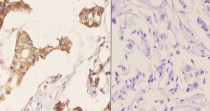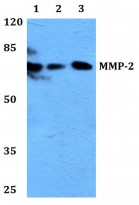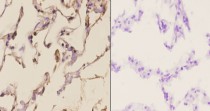ARG56426
anti-MMP2 antibody
anti-MMP2 antibody for IHC-Formalin-fixed paraffin-embedded sections,Western blot and Human,Mouse,Rat
Overview
| Product Description | Rabbit Polyclonal antibody recognizes MMP2 |
|---|---|
| Tested Reactivity | Hu, Ms, Rat |
| Tested Application | IHC-P, WB |
| Specificity | This antibody detects endogenous levels of MMP2 protein. |
| Host | Rabbit |
| Clonality | Polyclonal |
| Isotype | IgG |
| Target Name | MMP2 |
| Antigen Species | Human |
| Immunogen | Synthetic peptide around aa. 601-650 of Human MMP2. |
| Conjugation | Un-conjugated |
| Alternate Names | CLG4A; MMP-2; TBE-1; MONA; CLG4; EC 3.4.24.24; Gelatinase A; Matrix metalloproteinase-2; MMP-II; 72 kDa gelatinase; 72 kDa type IV collagenase |
Application Instructions
| Application Suggestion |
|
||||||
|---|---|---|---|---|---|---|---|
| Application Note | * The dilutions indicate recommended starting dilutions and the optimal dilutions or concentrations should be determined by the scientist. |
Properties
| Form | Liquid |
|---|---|
| Purification | Affinity purification with immunogen. |
| Purity | > 95% (by SDS-PAGE). |
| Buffer | PBS (pH 7.2) and 0.05% Sodium azide. |
| Preservative | 0.05% Sodium azide |
| Concentration | 1 mg/ml |
| Storage Instruction | For continuous use, store undiluted antibody at 2-8°C for up to a week. For long-term storage, aliquot and store at -20°C or below. Storage in frost free freezers is not recommended. Avoid repeated freeze/thaw cycles. Suggest spin the vial prior to opening. The antibody solution should be gently mixed before use. |
| Note | For laboratory research only, not for drug, diagnostic or other use. |
Bioinformation
| Database Links | |
|---|---|
| Gene Symbol | MMP2 |
| Gene Full Name | matrix metallopeptidase 2 |
| Background | This gene is a member of the matrix metalloproteinase (MMP) gene family, that are zinc-dependent enzymes capable of cleaving components of the extracellular matrix and molecules involved in signal transduction. The protein encoded by this gene is a gelatinase A, type IV collagenase, that contains three fibronectin type II repeats in its catalytic site that allow binding of denatured type IV and V collagen and elastin. Unlike most MMP family members, activation of this protein can occur on the cell membrane. This enzyme can be activated extracellularly by proteases, or, intracellulary by its S-glutathiolation with no requirement for proteolytical removal of the pro-domain. This protein is thought to be involved in multiple pathways including roles in the nervous system, endometrial menstrual breakdown, regulation of vascularization, and metastasis. Mutations in this gene have been associated with Winchester syndrome and Nodulosis-Arthropathy-Osteolysis (NAO) syndrome. Alternative splicing results in multiple transcript variants encoding different isoforms. [provided by RefSeq, Oct 2014] |
| Function | Ubiquitinous metalloproteinase that is involved in diverse functions such as remodeling of the vasculature, angiogenesis, tissue repair, tumor invasion, inflammation, and atherosclerotic plaque rupture. As well as degrading extracellular matrix proteins, can also act on several nonmatrix proteins such as big endothelial 1 and beta-type CGRP promoting vasoconstriction. Also cleaves KISS at a Gly-|-Leu bond. Appears to have a role in myocardial cell death pathways. Contributes to myocardial oxidative stress by regulating the activity of GSK3beta. Cleaves GSK3beta in vitro. Involved in the formation of the fibrovascular tissues in association with MMP14. PEX, the C-terminal non-catalytic fragment of MMP2, posseses anti-angiogenic and anti-tumor properties and inhibits cell migration and cell adhesion to FGF2 and vitronectin. Ligand for integrinv/beta3 on the surface of blood vessels. Isoform 2: Mediates the proteolysis of CHUK/IKKA and initiates a primary innate immune response by inducing mitochondrial-nuclear stress signaling with activation of the pro-inflammatory NF-kappaB, NFAT and IRF transcriptional pathways. [UniProt] |
| Calculated MW | 74 kDa |
| PTM | Phosphorylation on multiple sites modulates enzymatic activity. Phosphorylated by PKC in vitro. The propeptide is processed by MMP14 (MT-MMP1) and MMP16 (MT-MMP3). Autocatalytic cleavage in the C-terminal produces the anti-angiogenic peptide, PEX. This processing appears to be facilitated by binding integrinv/beta3. |
Images (5) Click the Picture to Zoom In
-
ARG56426 anti-MMP2 antibody IHC-P image
Immunohistochemistry: Paraffin-embedded Human breast carcinoma tissue stained with ARG56426 anti-MMP2 antibody at 1:50 dilution. Negative control (right) using PBS instead of primary antibody.
-
ARG56426 anti-MMP2 antibody WB image
Western blot: 1) HEK293T, 2) Raw264.7, 3) H9C2 whole cell lysates stained with ARG56426 anti-MMP2 antibody at 1:500 dilution.
-
ARG56426 anti-MMP2 antibody IHC-P image
Immunohistochemistry: Paraffin-embedded Human lung carcinoma tissue stained with ARG56426 anti-MMP2 antibody at 1:50 dilution. Negative control (right) using PBS instead of primary antibody.
-
ARG56426 anti-MMP2 antibody IHC-P image
Immunohistochemistry: Paraffin-embedded Human esophageal carcinoma tissue stained with ARG56426 anti-MMP2 antibody at 1:50 dilution. Negative control (right) using PBS instead of primary antibody.
-
ARG56426 anti-MMP2 antibody WB image
Western blot: Gastric cancer cells stained with ARG56426 anti-MMP2 antibody.
From Limin Zhang et al. Heliyon (2024), doi: 10.1016/j.heliyon.2024.e30803, Fig. 5. C.
Specific References











